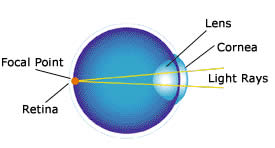
The human eye is excellent at picking up different colours and fine details. The position of the two eyes also means they can provide a tremendous range of visual information about what is being looked at. The powerful vision-processing areas of the brain then interpret this torrent of data into highly detailed mental images – which your memory then helps you to recognize.
The iris of the eye is the color portion behind the cornea. Our eye color is a function of the amount of pigment within the iris (brown eyes have the most pigment, while blue eyes have the least). The iris contains muscles that open and close its central opening called the pupil in response to decreases and increases in light exposure (exactly like the camera aperture).
Light then travels through the lens, where it is fine-tuned to focus properly on the retina, the nerve layer that lines the back of the eye and connects to the brain. The retina acts like the film in a camera, and clear vision is achieved only if light from an object is precisely focused onto it. If the light focuses either in front of or behind the retina, the image you see is blurred. A refractive error means that the shape of eye structures does not properly bend the light for focusing.
Picture Credit : Google
